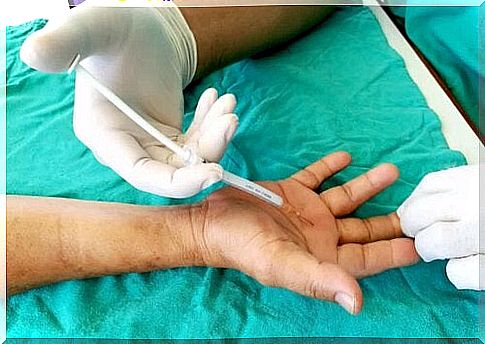What Is A Subcutaneous Injection And How Is It Administered?

A subcutaneous injection is quite common in the medical world. The reason is that the patient is able to administer it himself, as with insulin for those with diabetes.
A subcutaneous injection is injected into fat subcutaneous tissue. In other words, it goes into the fat layer that we find between the skin and the muscle. This tissue contains few blood vessels and is therefore suitable for small amounts of medication.
In addition, specialists recommend that the drug be absorbed slowly and continuously. Although easy to use, it is important to remember certain aspects of this type of administration.
What is a subcutaneous injection?
Subcutaneous injections are often confused with intradermal injections. The latter refers to an injection where the needle only penetrates the dermis (the middle layer of the skin).
Like the subcutaneous type, it is good for products that are absorbed slowly and locally. The difference between the two is the depth and the angle it enters. In the intradermal type, the needle enters at an angle of 10 degrees, almost parallel to the skin.
However, subcutaneous injections are those where the needle penetrates the subcutaneous tissue. We can find this tissue between the skin and the muscle layer. It is also known as adipose tissue .
Specialists use this area to administer medications in small amounts. In fact, it is usually in amounts less than 1 milliliter, although it can reach up to 2 milliliters. Because it is a tissue with few blood vessels, the body can absorb drugs from here gradually.
This is one of the main differences when comparing this type of injection with intravenous injections; intravenous injections have a faster effect. Subcutaneous injections are also easier to administer and cheaper. One of the most important uses is for drugs that someone can not take orally.

Tips before performing a subcutaneous injection
Unlike other injections, you should inhale after inserting the needle. This is a gesture that usually helps to check if the needle for intravenous injections is positioned correctly. However, it may leave a bruise.
In addition, specialists advise against massaging the area where you received the injection. This can cause the body to absorb the substance faster, which is not desirable here.
It is best to vary the place you take the injection in case you need to do it continuously. For example, this is what happens to insulin for those who have diabetes. In this way we can prevent wounds from forming.
The areas should be separated by a few centimeters. With insulin, we recommend that you administer it in circles to change the area where you inject yourself.
Materials for subcutaneous injections
To administer a subcutaneous injection, you will need different materials. The first is the syringe. This comes in three parts: needle, barrel and piston. The needle is the part that will penetrate the skin, while the dish is where you put the medicine. The plunger helps to squeeze the medicine out of the syringe.
Syringes may vary slightly, but all have readings to help you know how many ounces (or international units) you are going to use.
To perform a subcutaneous injection, use a new needle each time. They should be the right size. It is best to use disposable gloves when handling the needle or syringe because this reduces the risk of infection.
Specialists recommend that you have sterilized tissue at home that you can use as a surface to apply all materials to. It is also a good idea to have disinfectant alcohol or alcohol wipes.
How far should the needle go in?
A subcutaneous injection should have a certain depth and an appropriate angle. You can use it at 90 degrees (perpendicular) or at 45 degrees. You should do it at the first angle whenever you can, and at a 45-degree angle for those areas or people who have low fat tissue.
According to a publication in Murcia Salud , it is not always necessary to clean the skin before the injection. You should only do this in cases where the skin is visibly dirty.
It is also important to prepare the syringe before the process. You should use it with your dominant hand, between your thumb and forefinger. On the other hand, you need to grab the skin where you are going to administer the injection.
As a Kaiser Permanente article explains, you have to push the needle in with force. When it is completely inside, push the plunger so that the substance enters your body. After that, remove the needle at the same angle you inserted it.
Once this is done, you can release your skin with the other hand. You may bleed a little from where you put the injection. In this case, just press a little with a cotton pad, or gauze, as it is usually enough.

Where can you get a subcutaneous injection?
You can administer a subcutaneous injection in different areas of your body. One of the most common areas for this is the abdomen. You should stick the needle 2 inches away from the navel, and avoid getting too close. You should also avoid putting pressure on the hip bones or ribs.
Another area where you can get a subcutaneous injection is in the leg. Especially the outer area of the thigh, between the knee and the hip.
The lower back, just above the buttocks, is another area you can use. In this case, make sure that the injection is below the waist and above an imaginary line that rests just above the gluteal muscle. Finally, you can also take it in your arm.
Learning to do so reduces the risk
In summary, a subcutaneous injection is a type of injection that you administer to the adipose tissue between the skin and the muscle. People often use it to administer small amounts of medication. These drugs are also those that require a slow and gradual absorption.
One of the most important uses is to administer insulin. To do it right, we recommend that you change the place you inject yourself and prepare the materials correctly. In the same way, it is essential to follow the best sterile and antiseptic conditions.









